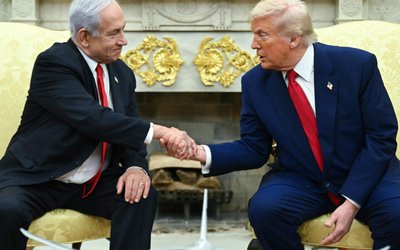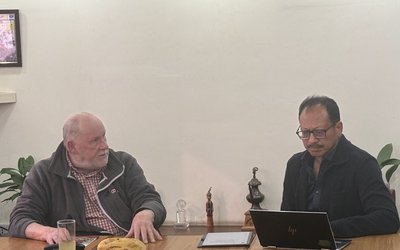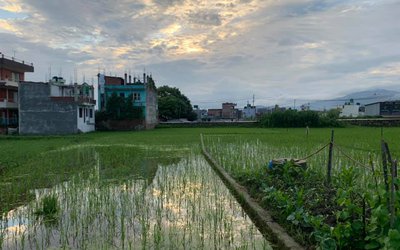
Professor DR. LOK RAJ BARAL needs no introduction. Having published several books on Nepal-India relations and Nepal’s political transformations, Professor Baral is known internationally for his scholarly works. After the publication of India Nepal Open Border, a field study on problems and prospects, a project supported by B.P. Koirala India Nepal Foundation, Baral spoke to KESHAB POUDEL on various issues related to the book and current prospects in Nepal India relations. Excerpts:
How do you look at the various dimensions of Nepal-India border in the context of your recent study?
Our studies have shown that the Nepal-India border is stable all the time. It continues to be so. We have not seen any encroachment in the border since Sugauli Treaty of 1814. In total, we have studied various aspects of open border, including social, cultural, economic, historical and human dynamics. We have also studied nature and scope, as well as people's involvement in border. Along with other, the study also deals with economy, terrorism, smuggling, fake currency and other security related issues of border. We also discuss the dynamics of open border and its scope.
Whenever one discusses the border issues, political matters remain dominant. Don't you think there are several human dimensions and human relations?
There is a vast difference between the realist and idealist thinking on open borders. In the realistic terms, our open border is a natural border and it is attached with historical and cultural contexts of Nepal. Our border was not politically demarcated till 1814. The issue of political border came very late, decades after the unification of Nepal. The issue of closed border was not in the imagination of Nepalese then. Despite the negative views of some scholarly people on open border, people living in border sides held the view that a closed border is unpractical and inapplicable. As the interaction of the people living on both sides of the border is so intense at matrimonial, livelihood, cultural and religious level, no one can ever imagine closing borders. For instance, we have found that many Nepalese have land across international borders vis-à-vis Indian citizens in Nepal. Although two countries are divided by political boundary, it does not make any difference in their day to day life. They have been living together for centuries normally.
What conclusion does your study draw?
After looking at all kinds of interaction, we draw the conclusion that Nepal-India open border is one of the unique borders of the world. Although European countries have opened their borders recently, I have not seen such a unique character as it is involved in Nepal India border. Europe's border opens through the multilateral agreement after reaching at certain level of maturity. Tens of thousands of people have been crossing Nepal-India border every day. Thus, we need to look at the border management through humanistic approach. For this, we need to have positive thinking on entire border issues.
What do we need to do?
Our efforts must be directed to make the life of people living on both sides of the border prosperous and happy. There should not be any negative thinking about closing the border. It is impossible to close Nepal-India open border. If we close the border, it will have a lot more negative implications. We cannot maintain the closed border. Despite fencing over 1700 kilometers of India-Bangladesh border, it has not settled the problems. Despite fencing India-Pakistan border, it has not stopped sneaking in the border. Look at highly fenced U.S.-Mexico border, it failed to settle the problems. So far as Nepal-India border is concerned, it has different historical, religious, human and cultural aspects which make it impossible to close the border. If somebody in Nepal makes efforts to close the border, there will be explosion. It will definitely bring another upheaval with any kind of consequence in Nepal. One has to look at this sensitive border with sympathetic views and with realistic approach.
If it involves so many dimensions of human life, why do then Kathmandu based elites prefer to take irritating steps and actions?
Our psychology is that we rarely make effort to understand the fundamentals of our border. The border issue appears in news headline on the basis of small incidents like sporadic manhandling by police of both the countries and smugglings of goods. Being a big country, this kind of small incident rarely makes any headline in national newspapers in India. However, such incidents are taken as big incidents in Nepal. This is a psychology of small state -- even the media reacts over small incidents. Such tendency contributed to build negative perceptions. Small and minor incidents overwhelmed fundamental factors like human, cultural, religious and economic aspects of Nepal-India open border. This contributes to the imbalance in thinking about Nepal-India relations. One cannot understand Nepal-India open border and Nepal-India relations without studying complexity, depth and other factors involved.
How do you look at the role of rivers in creating problems in Nepal India border?
Being a person who grew up in eastern border town of Bhadrapur, I myself had seen the shifting of the border by the course of Mechi River. I had seen how the course of Mechi River shifts border from one to the other end. In this natural course, our settlement and border landscape has been changing. Thus, I am saying this is a unique border in the world. The rivers like Gandak, Mahakali, Kosi, Babai, Mechi Kamala and Bagmati are changing their courses. People normally used the land in their favor when the river changed the course.
If Nepal-India open border is the lifeline to those who live near the border, what are the challenges?
It is their lifeline. The major challenge is the management of humans living on both the sides sharing each other's land. Although the border is demarcated in most of the areas, the question is how to manage the people. In many places, people of both the countries have been living in no man's land. In some places there still remains the Dasgaja (No man's land). However, it is not the case in all the areas, particularly the areas with dense population like Jogbani, Krishnanagar, west of Birgunj and others. When we talk about the management of border, it also involves money as well as the question of rehabilitation of huge population living in Dasgaja. Thus, I am repeatedly saying that human dimension is very important in Nepal-India open border. How can one uproot the people who have been living there for centuries? When we are unable to vacate the banks of Bagmati River, which is recently encroached by people, it is impossible to evacuate the people from borders where they have been living for centuries.
What do you suggest is the right thing to do?
There is no way other than to maintain status quo. We have not mentioned this point in our report. As I mentioned, our border involves complex issues. There is economy, human life, culture, religion and all other social aspects. My suggestion is that we need to demarcate the areas only where it is possible.
When there are discussions on Nepal-India relations, why do people ignore the realism?
We are yet to mature for handling relations. We have tendencies to linger on decisions by creating negative impression. In reality, Nepal India relations are very deep rooted in our culture, social life and values. We have to deal with India in all aspects. However, our intellectuals have changed the mindset of younger people by championing negative slogans.
Who do you blame for this?
Our problem is our political leadership. Our leaders are not confident about the possibility to make Nepal prosperous, developed and rich. Nationalism is strengthened only when we empower people. One cannot be a nationalist by just harping on anti-Indian slogans. We need to maintain a good understanding with India. Thus, we need to take the right decision with India to make Nepalese economically prosperous and rich. There is a gap. One section of Nepalese has been always saying that 1950 Nepal India Treaty of Friendship is unequal. However, the treaty clearly spells out the equal sovereignty of two countries and respect of sovereignty, equality and independence. Nepal and India signed the Treaty of 1950 willingly. In that context, whoever might be in power, he or she had to sign that kind of treaty. Even King Mahendra signed 1965 security understanding with India. Then Indian ambassador, Sriman Narayan wrote in his book, how King Mahendra accepted the security sensitivity of India in handling the projects in Terai. You need to follow pragmatism in handling foreign affairs. Bilateral relations are always based on realism not idealism. This is not an exception in our context.
- MELAMCHI WATER SUPPLY: No Interruption During Monsoon
- Jun 25, 2025
- KOREAN RETURNEES: Successful Integration
- Jun 25, 2025
- UPPER TRISHULI-1: Engaging With Local
- Jun 25, 2025
- IME GROUP: Twenty Five Years Of Journey
- Jun 24, 2025
- NEPAL’S AIR POLLUTION: A Growing Health Concern
- Jun 24, 2025















